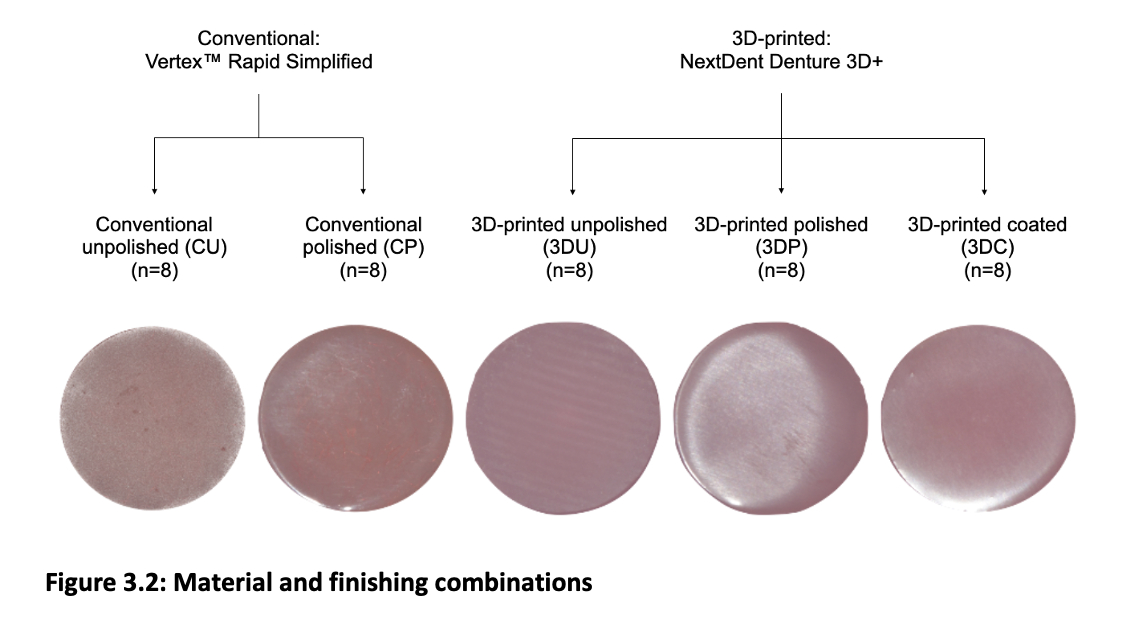IADR Abstract Archives
In Vitro adhesion of Candida albicans on 3D-Printed Denture Bases
Objectives: To investigate, in vitro, the impact of resin types (3D printed VS conventional denture resin) and finishing protocols on surface roughness and adhesion of C. albicans.
Methods: 5 experimental groups were manufactured via 3D printing or conventional fabrication. They were then subjected to 3 post fabrication surface treatment protocols. The groups were: 3D printed unpolished resin (3DU); 3D printed polished resin (3DP); 3D printed coated resin (3DC) and conventional unpolished resin (CU); conventional polished resin (CP). 8 samples for each group were prepared and immersed in distilled water for 6 days of water aging. After which, they were sterilized under UV light. Biofilm quantification was performed using XTT assay and colony forming units (CFU) count to determine levels of C. albicans adhesion. 2 time points of 24 hours and 48 hours were done for each method i.e. 24h-XTT, 48h-XTT, 24h-CFU and 48h-CFU. Surface roughness (Ra) of the samples was measured immediately after fabrication. Results were collected and statistically analysed using One-way ANOVA, Kruskal-Wallis tests and Spearman’s rank correlation coefficient.
Results: 3DU showed significantly greater surface roughness than CU (P < 0.05), while no statistical difference was found between 3DP and CP (P > 0.05). Polishing significantly reduced surface roughness for both conventional and 3D printed samples (P < 0.05). Coating significantly reduced surface roughness of 3D printed samples (P < 0.05)
3DU showed significantly greater C. albicans adhesion than CU (P < 0.05). 3DP showed significantly greater C. albicans adhesion than CP only at 48 hours (P < 0.05). CU showed greater C. albicans adhesion than CP, significance was found for 48h-CFU (P < 0.05), and not found in 24h-XTT, 48h-XTT and 24h-CFU (P > 0.05). C. albicans adhesion showed a consistent trend of 3DP < 3DC < 3DU, with statistical significance at 48 hours.
Additionally, a positive correlation was found between surface roughness and C. albicans adhesion (P < 0.05).
Conclusions: The unpolished 3D printed denture resin presents with significantly higher surface roughness and C. albicans adhesion compared to conventional denture resin. Use of a 3D printed denture may increase the risk for developing denture stomatitis. Coating the intaglio of a 3D printed denture may help to reduce this risk.
Methods: 5 experimental groups were manufactured via 3D printing or conventional fabrication. They were then subjected to 3 post fabrication surface treatment protocols. The groups were: 3D printed unpolished resin (3DU); 3D printed polished resin (3DP); 3D printed coated resin (3DC) and conventional unpolished resin (CU); conventional polished resin (CP). 8 samples for each group were prepared and immersed in distilled water for 6 days of water aging. After which, they were sterilized under UV light. Biofilm quantification was performed using XTT assay and colony forming units (CFU) count to determine levels of C. albicans adhesion. 2 time points of 24 hours and 48 hours were done for each method i.e. 24h-XTT, 48h-XTT, 24h-CFU and 48h-CFU. Surface roughness (Ra) of the samples was measured immediately after fabrication. Results were collected and statistically analysed using One-way ANOVA, Kruskal-Wallis tests and Spearman’s rank correlation coefficient.
Results: 3DU showed significantly greater surface roughness than CU (P < 0.05), while no statistical difference was found between 3DP and CP (P > 0.05). Polishing significantly reduced surface roughness for both conventional and 3D printed samples (P < 0.05). Coating significantly reduced surface roughness of 3D printed samples (P < 0.05)
3DU showed significantly greater C. albicans adhesion than CU (P < 0.05). 3DP showed significantly greater C. albicans adhesion than CP only at 48 hours (P < 0.05). CU showed greater C. albicans adhesion than CP, significance was found for 48h-CFU (P < 0.05), and not found in 24h-XTT, 48h-XTT and 24h-CFU (P > 0.05). C. albicans adhesion showed a consistent trend of 3DP < 3DC < 3DU, with statistical significance at 48 hours.
Additionally, a positive correlation was found between surface roughness and C. albicans adhesion (P < 0.05).
Conclusions: The unpolished 3D printed denture resin presents with significantly higher surface roughness and C. albicans adhesion compared to conventional denture resin. Use of a 3D printed denture may increase the risk for developing denture stomatitis. Coating the intaglio of a 3D printed denture may help to reduce this risk.



